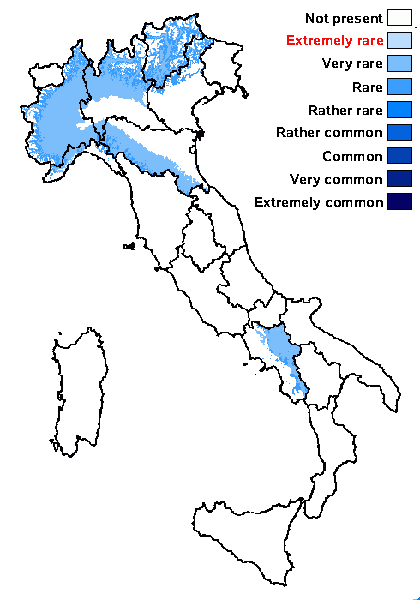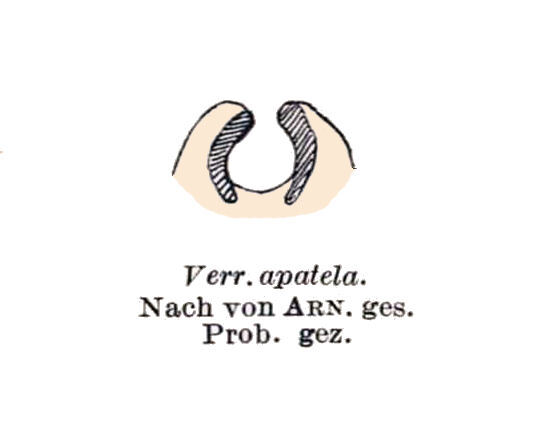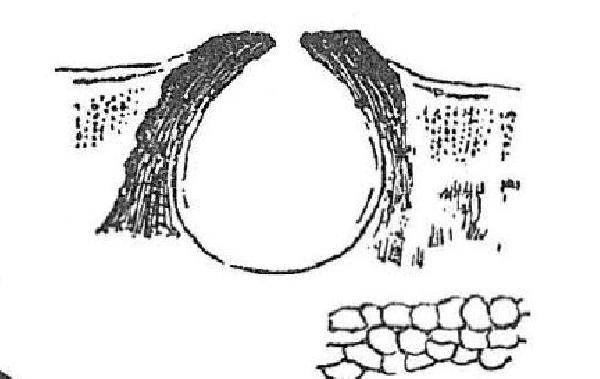Verrucaria apatela (A. Massal.) Trevis.
Consp. Verruc.: 7, 1860. Basionym: Lithocia apatela A. Massal. - Framm. Lichenogr.: 23, 1855.
Synonyms: Verrucaria monguilloni Servít
Distribution: N - Ven (Lazzarin 2000b, Breuss 2008b), TAA, Lomb, Piem (Isocrono & al. 2004), Emil (Fariselli & al. 2020), Lig (Watson 2014). S - Camp (Ricciardi & al. 2000).
Description: Thallus crustose to subsquamulose, episubstratic, areolate, 0.25-0.4 mm thick, brown, matt, the areoles 0.3-0.7 mm wide, flat, rounded-angular to weakly lobed, more or less smooth. Cortex c. 20 µm thick, paraplectenchymatous with small cells (3-4 µm); algal layer 100-150 µm thick; medulla white to brownish, filled with granules and crystals. Perithecia black, fully immersed in the areoles, the apex appearing as a small black dot. Involucrellum reaching to base-level, 50-60 µm thick in upper part, to 110 µm thick in lower part; exciple subglobose, 0.25-0.5 mm across, the wall brownish throughout; hamathecium of simple or sparingly branched, 50-70 µm long periphyses and periphysoids, interascal filaments absent; hymenial gel hemiamyloid, I+ red (I+ blue at very low concentrations of I), K/I+ blue. Asci 8-spored, 80-95 x 25-30 µm, clavate, I-, fissitunicate, the wall thickened above, with an ocular chamber, dehiscent by extrusion of an endotunica to form a delicate rostrum, Verrucaria-type; Ascospores 1-celled, hyaline, ellipsoid, 23-28 x 12-15 µm. Photobiont chlorococcoid. Spot tests: K-, C-, KC-, P-, UV-. Chemistry: without lichen substances.
Note: on steeply inclined faces of limestone and dolomite. Reported from many sites in Central and Southern Europe; closely related to V. macrostoma. For further details see Breuss (2008b).
Growth form: Crustose
Substrata: rocks
Photobiont: green algae other than Trentepohlia
Reproductive strategy: mainly sexual
Poorly known taxon in need of further study
Commonnes-rarity: (info)
Alpine belt: absent
Subalpine belt: very rare
Oromediterranean belt: very rare
Montane belt: rare
Submediterranean belt: very rare
Padanian area: absent
Humid submediterranean belt: absent
Humid mediterranean belt: absent
Dry mediterranean belt: absent

Predictive model

Collezione lichenologica Abramo Massalongo del Museo di Storia Naturale G. Ligabue di Venezia - Autori: Seggi, Linda; Trabucco, Raffaella Proprietà: Fondazione Musei Civici di Venezia - CC BY-NC
Italy, Veneto, ad saxa eocenica circa Urbem Veronam 1855
As Lithoicea apatela

Collezione lichenologica Abramo Massalongo del Museo di Storia Naturale G. Ligabue di Venezia - Autori: Seggi, Linda; Trabucco, Raffaella Proprietà: Fondazione Musei Civici di Venezia - CC BY-NC
Italy, Veneto, ad saxa eocenica circa Urbem Veronam 1855
As Lithoicea apatela

Collezione lichenologica Abramo Massalongo del Museo di Storia Naturale G. Ligabue di Venezia - Autori: Seggi, Linda; Trabucco, Raffaella Proprietà: Fondazione Musei Civici di Venezia - CC BY-NC
Italy, Veneto, ad saxa eocenica circa Urbem Veronam 1855
As Lithoicea apatela
Growth form: Crustose
Substrata: rocks
Photobiont: green algae other than Trentepohlia
Reproductive strategy: mainly sexual
Poorly known taxon in need of further study
Commonnes-rarity: (info)
Alpine belt: absent
Subalpine belt: very rare
Oromediterranean belt: very rare
Montane belt: rare
Submediterranean belt: very rare
Padanian area: absent
Humid submediterranean belt: absent
Humid mediterranean belt: absent
Dry mediterranean belt: absent

Predictive model

Collezione lichenologica Abramo Massalongo del Museo di Storia Naturale G. Ligabue di Venezia - Autori: Seggi, Linda; Trabucco, Raffaella Proprietà: Fondazione Musei Civici di Venezia - CC BY-NC
Italy, Veneto, ad saxa eocenica circa Urbem Veronam 1855
As Lithoicea apatela

Collezione lichenologica Abramo Massalongo del Museo di Storia Naturale G. Ligabue di Venezia - Autori: Seggi, Linda; Trabucco, Raffaella Proprietà: Fondazione Musei Civici di Venezia - CC BY-NC
Italy, Veneto, ad saxa eocenica circa Urbem Veronam 1855
As Lithoicea apatela

 INDEX FUNGORUM
INDEX FUNGORUM
 GBIF
GBIF
 DOLICHENS
DOLICHENS




